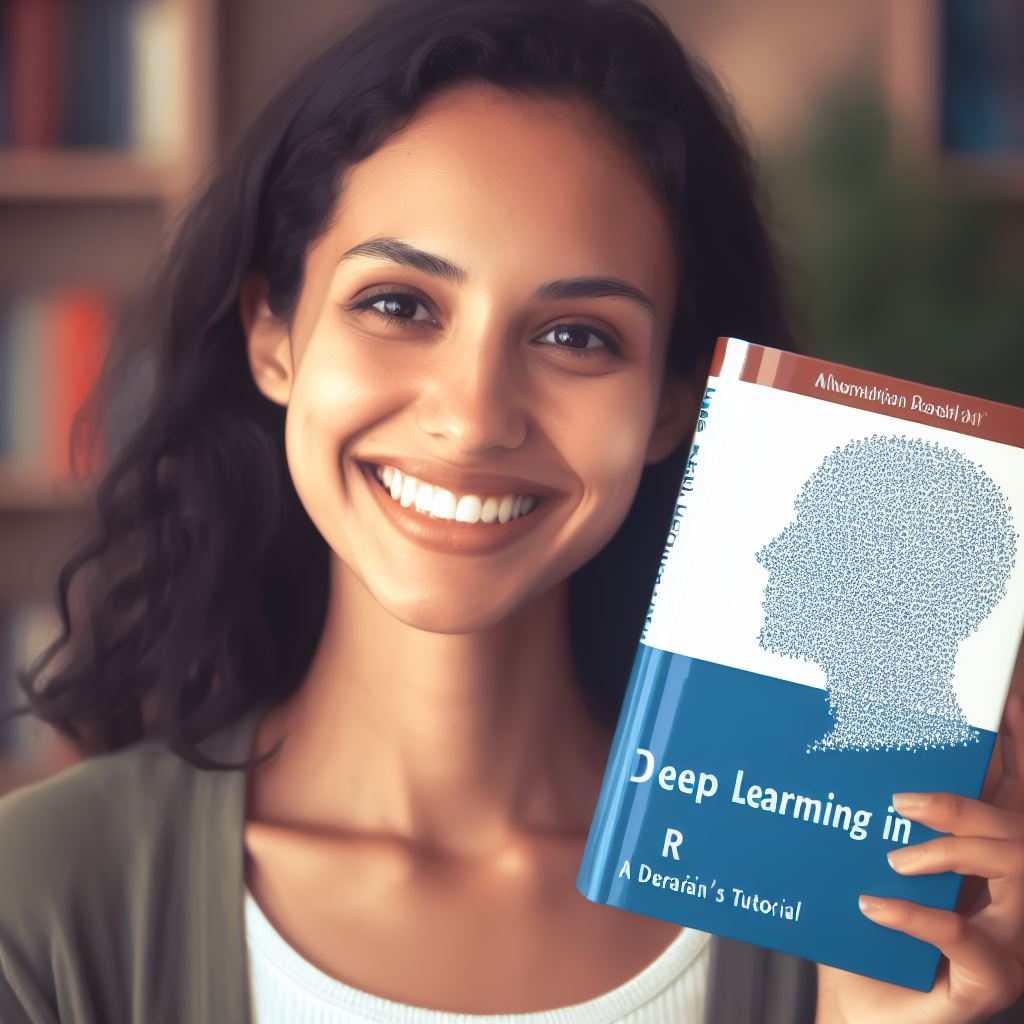Introduction
Deep learning, a subset of machine learning, simulates the human brain’s neural networks to analyze and process vast datasets.
Its popularity has surged across diverse industries, including healthcare, finance, and technology, thanks to its ability to extract intricate patterns and make complex decisions.
In this introductory blog post, we embark on a journey into the world of deep learning in R.
As we unravel its applications and significance in various fields, readers will gain insights into the transformative power of this technology.
Whether you’re a novice or an experienced data enthusiast, this beginner’s tutorial aims to demystify the concepts of deep learning and pave the way for exploring its potential in your projects.
What is R and why use it for deep learning?
R is a widely used programming language for statistical analysis and data visualization.
It provides several advantages for deep learning tasks due to its flexibility, extensive library support, and active community.
Advantages of using R for deep learning
- Open source: R is an open-source language, freely available to everyone. It allows users to modify and distribute code without any restrictions, making it ideal for collaborative research and development.
- Statistical analysis capabilities: R is renowned for its statistical analysis capabilities, which are crucial for analyzing data in deep learning applications. It provides numerous packages and functions for data manipulation, visualization, and modeling.
- Data handling and preprocessing: R offers a variety of packages, such as dplyr and tidyr, which simplify data handling and preprocessing tasks. These packages enable users to clean and preprocess large datasets efficiently before feeding them into deep learning models.
- Visualization: R provides powerful visualization libraries like ggplot2, which helps in visually exploring and understanding complex deep learning datasets. Visualizing data can provide crucial insights and facilitate model interpretation.
- Integration with other languages and tools: R can be easily integrated with other programming languages like Python and C++. This integration allows users to leverage the strengths of other languages while benefiting from R’s deep learning capabilities.
- Extensive library support: R has a vast and continuously growing library ecosystem specifically focused on machine learning and deep learning. Popular libraries like TensorFlow, Keras, and MXNet provide high-level interfaces for building and training deep learning models.
Popular deep learning libraries available in R
- TensorFlow: TensorFlow is a powerful deep learning library that provides a flexible ecosystem for building and training various neural network architectures. Its integration with R allows users to leverage TensorFlow’s extensive functionalities.
- Keras: Keras is a high-level neural networks API that runs on top of TensorFlow. It simplifies the process of building and training deep learning models and is widely used for its user-friendly interface and ease of implementation.
- MXNet: MXNet is a highly scalable deep learning library that provides both high-level and low-level programming interfaces. MXNet offers excellent performance, especially when dealing with large-scale deep learning projects.
- Caret: Caret is a versatile machine learning library in R that provides a unified interface for training and evaluating various machine learning models, including deep learning models. It streamlines the process of model selection and hyperparameter tuning.
Therefore, R is a powerful programming language for deep learning due to its open-source nature, statistical analysis capabilities, data handling functionalities, and extensive library support.
With popular libraries like TensorFlow, Keras, MXNet, and Caret available, R provides a comprehensive ecosystem for developing and deploying deep learning models.
Read: Comparing R with SAS for Statistical Analysis
Setting up the Environment
In this section, we will guide you through the process of setting up your environment for deep learning in R.
We will cover the installation of R and RStudio, the required R packages for deep learning, and any additional tools that may be necessary.
Installing R and RStudio
- Download the latest version of R from the official website (https://www.r-project.org/).
- Follow the installation instructions specific to your operating system.
- Once R is installed, download and install RStudio IDE from (https://www.rstudio.com/products/rstudio/download/).
- Choose the appropriate version based on your operating system and follow the installation instructions.
Installing Required R Packages for Deep Learning
Open RStudio and create a new R script.
To install the necessary packages for deep learning, run the following commands:
```R
install.packages("keras")
install.packages("tensorflow")
install.packages("reticulate")
```Wait for the packages to be downloaded and installed. Any dependencies will also be installed automatically.
Tech Consulting Tailored to Your Coding Journey
Get expert guidance in coding with a personalized consultation. Receive unique, actionable insights delivered in 1-3 business days.
Get StartedInstalling Additional Tools
If you plan to use GPU acceleration for deep learning, additional tools may be required.
- Install CUDA Toolkit: Visit the official NVIDIA website (https://developer.nvidia.com/cuda-toolkit-archive) and download the latest CUDA Toolkit compatible with your GPU model.
- Follow the installation instructions provided by NVIDIA for your operating system.
- Install cuDNN: Visit the NVIDIA Developer website (https://developer.nvidia.com/rdp/cudnn-archive) and download the cuDNN library that matches your CUDA Toolkit version.
- Extract the downloaded cuDNN package and follow the installation instructions provided by NVIDIA.
Once the environment is set up, you are ready to start working with deep learning in R.
In the next section, we will explore the basics of deep learning and how to build and train your first deep learning model using R.
In this section, we walked you through the process of setting up your environment for deep learning in R.
We explained how to install R and RStudio, discussed the installation of required R packages, and provided guidance on installing additional tools if necessary.
Now that your environment is ready, you can dive into the exciting world of deep learning with R!
Read: Advanced R Programming: Tips for Experts
Understanding the basics of deep learning
Deep learning is a powerful branch of artificial intelligence that has gained significant attention in recent years.
It involves training neural networks, which are computational models consisting of layers of interconnected artificial neurons.
To fully grasp the principles of deep learning, it is important to understand key terms and concepts.
Here, we will define and explain some of the fundamental concepts in deep learning:
Neural Networks
Artificial neurons process and transmit information in intricate neural network systems, drawing inspiration from the human brain’s structure.
They are the foundation of deep learning models.
Layers
In deep learning, a neural network is organized into layers.
Build Your Vision, Perfectly Tailored
Get a custom-built website or application that matches your vision and needs. Stand out from the crowd with a solution designed just for you—professional, scalable, and seamless.
Get StartedEach layer is responsible for performing specific computations on the input data received from the previous layer.
Neurons
Neurons are individual computing units within a layer of a neural network.
They receive inputs, apply a mathematical function, and produce an output that is transmitted to the next layer.
Weights
Weights are the parameters that determine the strength of the connections between neurons.
They are adjusted during the training process to optimize the performance of the neural network.
Activations
Activations refer to the outputs produced by the neurons after applying a mathematical function to their inputs.
They determine the intensity of the signal passed to the next layer.
Now that we have defined the key terms, let’s explore the concept of forward and backward propagation:
Forward Propagation
Forward propagation involves passing the input data through the neural network, layer by layer, from the input layer to the output layer.
Multiply inputs by weights, calculate activations, and repeat the process at each layer until obtaining the final output.
Backward Propagation
Backward propagation, also known as backpropagation, is the process of adjusting the weights of the neural network based on the difference between the predicted output and the actual output.
This adjustment occurs layer by layer, starting from the output layer and moving backwards towards the input layer.
Loss functions and optimization algorithms play a crucial role in deep learning:
Loss Functions
It measure the discrepancy between the predicted output of the neural network and the true output.
Optimize Your Profile, Get Noticed
Make your resume and LinkedIn stand out to employers with a profile that highlights your technical skills and project experience. Elevate your career with a polished and professional presence.
Get NoticedDuring training, these metrics quantitatively measure the model’s performance and play a crucial role in updating the weights.
Optimization Algorithms
Optimization algorithms are used to minimize the loss function by adjusting the weights of the neural network.
These algorithms employ various techniques, such as gradient descent, to iteratively update the weights and improve the model’s performance.
In essence, deep learning relies on neural networks, layers, neurons, weights, and activations to process and analyze data.
The concepts of forward and backward propagation, along with the role of loss functions and optimization algorithms, are essential for understanding and effectively applying deep learning techniques.
Read: Integrating R with SQL: A Practical Approach

Implementing deep learning in R: A Beginner’s Tutorial
Deep learning has gained immense popularity in the field of artificial intelligence and machine learning.
It has proven to be highly effective in solving complex problems and providing accurate predictions.
In this tutorial, we will explore how to implement deep learning in R, providing a step-by-step guide for beginners.
Importing and preprocessing data in R
- Start by installing the necessary packages for deep learning in R, such as “keras” and “tensorflow”.
- Import the dataset you want to work with into R using functions like “read.csv()” or “read.table()”.
- Explore the data to gain insights and identify any missing values or inconsistencies.
- Clean the data by handling missing values, removing outliers, and normalizing the features.
- Split the dataset into training and testing sets to evaluate the performance of the deep learning model.
Building neural networks in R
- Start by defining the architecture of the neural network using functions from the “keras” package.
- Create layers in the neural network using functions like “layer_dense()” or “layer_dropout()”.
- Customize the architecture by specifying activation functions, dropout rates, and number of units in each layer.
- Define a loss function and an optimizer to optimize the neural network model.
- Compile the model using the “compile()” function to prepare it for training.
Training and evaluating deep learning models in R
- Train the deep learning model by fitting it to the training data using the “fit()” function.
- Specify the number of epochs and batch size to control the training process.
- Monitor the model’s performance on the training set and evaluate its performance on the testing set.
- Calculate metrics such as accuracy, precision, recall, and F1-score to assess the model’s performance.
- Fine-tune the model by adjusting hyperparameters, adding regularization, or using different optimization techniques.
Examples of deep learning architectures and techniques in R
- Convolutional Neural Networks (CNN): Used for image classification and object recognition tasks.
- Convolutional Neural Networks (CNN): Effective for natural language processing and sequential data analysis.
- Generative Adversarial Networks (GAN): Used to generate new data samples based on a given dataset.
- Transfer Learning: Utilizing pre-trained deep learning models to solve related tasks or limited datasets.
- Autoencoders: Used for dimensionality reduction, feature extraction, or anomaly detection.
In fact, implementing deep learning in R can be made easier by following a step-by-step guide.
Importing and preprocessing data, building neural networks, training and evaluating models, and exploring various architectures are all essential steps in the process.
By utilizing popular R libraries and functions, anyone can venture into the fascinating world of deep learning and unlock its potential for solving complex problems.
Read: Freelance vs Full-Time Coding Jobs: Pros and Cons
Real-world applications of deep learning in R
Deep learning in R is a powerful tool that has found applications in various fields.
Let’s explore some of the real-world applications where neural network is being successfully implemented using R.
Healthcare
Healthcare professionals use R for disease diagnosis, medical imaging analysis, and predicting patient outcomes with neural network models.
Finance
R employs neural network algorithms for stock market prediction, algorithmic trading, fraud detection, and credit scoring in finance..
Natural Language Processing (NLP)
Deep learning techniques in R drive sentiment analysis, text generation, machine translation, and question-answering systems in NLP.
Computer Vision
In R, we leverage deep learning models for tasks like image classification, object detection, facial recognition, and autonomous driving systems.
Recommendation Systems
Deep learning algorithms in R play a significant role in building recommender systems for personalized product recommendations and content filtering.
Social Media Analysis
Deep learning in R helps analyze social media data for sentiment analysis, trend detection, topic modeling, and user behavior prediction.
Genomics
Deep learning models in R aid in genomic sequence analysis, gene expression prediction, protein structure prediction, and drug discovery.
These are just a few examples of the multiple fields where deep learning in R is making a remarkable impact.
Now, let’s delve into some specific use cases and success stories.
Use Cases and Success Stories
1. Cancer Diagnosis
Researchers used deep learning in R to develop a model that accurately detected breast cancer tumors from medical images with over 95% accuracy.
2. Autonomous Driving
A company utilized neural network algorithms in R to train a self-driving car that successfully navigated complex road scenarios without human intervention.
3. Fraud Detection
Financial institutions implemented deep learning models in R to detect fraudulent transactions, reducing false-positive rates and saving millions of dollars.
4. Natural Language Processing
Employing neural network techniques in R, we created a chatbot offering personalized customer support, enhancing user satisfaction.
If you are interested in exploring more applications of deep learning in R, here are some recommended resources:
- “Deep Learning with R” – A comprehensive book by François Chollet that covers deep learning concepts and practical implementations in R.
- “RStudio’s Deep Learning with TensorFlow and Keras” – An online course that demonstrates how to use R for deep learning using TensorFlow and Keras libraries.
- “R-bloggers” – A popular blog platform where you can find articles and tutorials on deep learning implementations in R.
With the increasing popularity of neural network in R, it is exciting to witness the transformative impact it is having across diverse industries.
Conclusion
This blog post has covered the fundamentals of neural network in R.
We discussed the importance of understanding neural networks, deep learning libraries, and the steps involved in model development.
It is essential for aspiring data scientists to start their neural Network journey in R as it offers a wide range of resources and packages.
By mastering R for neural network, one can strengthen their skillset and make significant contributions in the field.
If you wish to delve deeper into this topic, here are some additional resources for learning and further exploration:
- “Deep Learning with R” book by François Chollet
- “R Package Documentation for Neural Networks” by Stefan Feinerer
- “Neural Network Inference with Keras and R” course on DataCamp
- Kaggle competitions on neural Network in R
- Online forums and communities such as the R Studio Community and Stack Overflow.
No matter your level of expertise, continuous learning and practice will lead to proficiency in deep learning using R.
Start your journey today!




